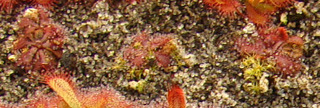Drosera natalensis - The Natal SundewDrosera natalensis is a charming rosetted South African sundew. It can develop beautiful red-orange coloration under bright light. This subtropical sundew is generally very easy to grow, and is a great choice for beginner sundew growers. Drosera natalensis is very often confused with Drosera dielsiana in cultivation (this already happened to me), so make sure you have the right i.d. for your plant. |
|
| Drosera natalensis can turn orange-red if given enough light. Drosera natalensis after 2 months of feeding. See picture below for comparison.  D.
natalensis before being fed every 2
weeks
D.
natalensis before being fed every 2
weeks for a total of 2 months. The plants stayed at this size for 6 months before I decided to feed them. Once fed, they began rapid growth. Drosera natalensis ssp. Chimanimane |
Media: 1:1 peat: sand (silica) has worked best for me. Drosera natalensis isn't picky. Small amounts of perlite can be added. Media moisture: keep moist. isn't picky. Humidity: very little is needed with the tray method, if there is little or no air movement. Pot height: 3.5 inches or taller. Not picky. Trapping speed: moderate. Leaves will curl around prey within a few hours. Feeding: If fed every 2 weeks, grows extremly rapidly. See feeding page. Feeding also encourages flowering Check out the 2 month photo documentation I made of D. natalensis when fed over 2 months. Food size: medium to large. Plant dimensions: generally more compact than many other rosetted South African sundews. The form I grow reaches about 1-1.5 inches at maturity. Temperature: not picky. Drosera natalensis can handle both low and high temperatures just fine. I'd recommend a range of 55-85 degrees F for optimal growth, but it can survive warmer temps. Lighting/Photoperiod: Not picky at all. D. natalensis will develop bright red coloration if grown under strong light. If fed and is growing quickly, leaves will have a yellow-green hue with bright red tentacles. Dormancy requirements: None. Can be grown year-round if given warm enough temps. If subjected to frost, Drosera natalensis will die down and come back from roots when temperatures are favorable again. Flowers: Self-pollinates. Drosera natalensis produces a lot of flower stalks and incredible amounts of seed. 1 flower can produce up to 100 seeds. Flowers are fairly small and pink. Propagation Techniquesfor detailed instructions, visit the sundew propagation page.Seed: very easy. Cold stratification is not required. Can reach flowering maturity in 7 months or less if fed regularly. Be sure to check out my seed germination gude. Leaf Cuttings: easy. Water floating method works best. Place directly under lights for the highest success rate. Root Cuttings: very easyLeaf cuttings: easy. Root Cuttings: very easy. Drosera natalensis has very thick roots, perfect for cuttings. Divisions: D. natalensis tends to clump over time. This plant can handle root disturbance well, so divisions can be made any time as long as you are somewhat careful. |
Additional Questions or Suggestions?
Contact me at: sundewman(at)yahoo.com